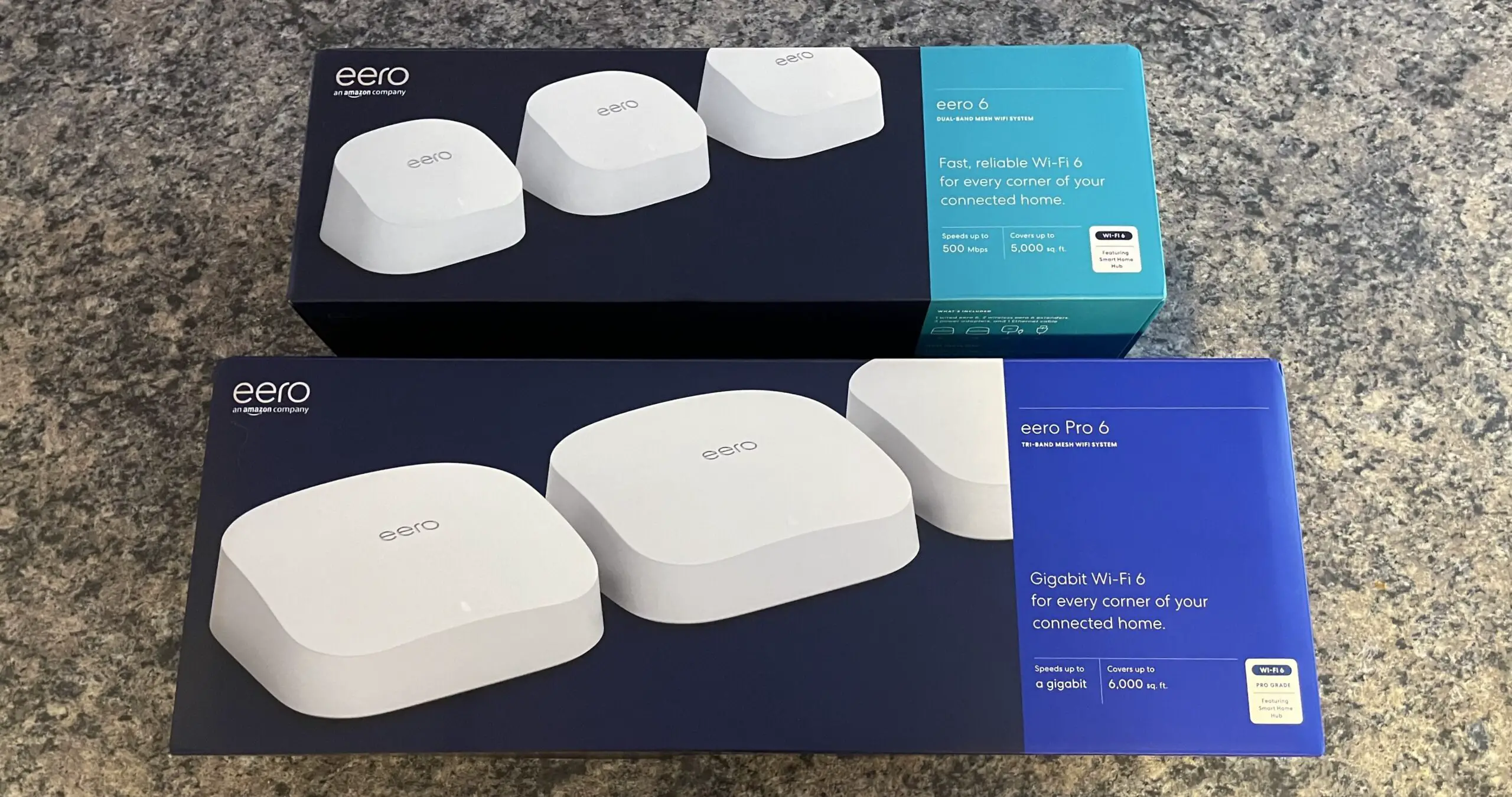If you’re paying for the higher speeds from your ISP (200Mpbs or more), then you need a mesh router that ensures everyone can enjoy those speeds without dips and slow downs. That’s where the Eero 6 and Eero Pro 6 come in. These two routers are great, but which is best for your home? We’re going to compare Eero 6 vs Eero Pro 6 to see which works for you.
We’re going to compare these based on user friendliness, performance, and design. While Eero Pro 6 definitely pulls its weight, Eero 6 is a good value and nearly as versatile.
User Friendliness
This section will cover how easy the Eero 6 routers are to use and what user-friendly features you get with them. It’s difficult to pick a winner here since the two are nearly identical in this aspect. In fact, Eero is already a user friendly brand in general, and many of those features from previous routers were passed onto the newest versions.
Installation
When it comes to installation, both Eero 6 and Eero Pro 6 are simple. You get simple instructions inside the Eero app and there’s really no way to mess it up. You should have either router installed in 5-10 minutes even if this is your first mesh router.
App and Software
The Eero app makes things even easier. This allows you to see all your devices, and you can create a family profile. You can schedule access times, create downtime periods, or even stop the whole network right from the app.
These features are ideal for parents. You can monitor how often your kids use the internet, and you can easily turn the internet on and off as needed. Both models work with Alexa. Use voice commands to pause someone’s profile. If your phone is lost, then Alexa can tell you which node your device is closest to.
You can generate a guest network and you can change the network’s name, DNS service, IP reservations, port forwarding, and UPnP. This is more than what average users need, but not quite enough for “network nerds.”
Lastly, there’s an option to see real-time bandwidth usage. This helps you see if any are lagging behind because that could be a problem.
Downsides
As great as Eero 6 and Eero Pro 6 are, there are some downsides. Some basic features you get with Google WiFi are only available through a $3/month paywall with Eero Secure. The bandwidth usage interface only allows you to see per day or per month usage, nothing in between. It also lacks advanced parental controls for filtering or site blocking.
Another annoying feature is the auto firmware updates. This means that Eero automatically updates whenever a new firmware version is released. That may not sound bad, but it stops your internet while updating, which could be bad for gamers.
Lastly, there’s no web interface. The app is great, but it’d be nice to have a desktop version as well.
Lastly, when compared to previous versions of Eero, both 6 and 6 Pro have limited compatibility. They currently can’t connect to HomeKit. They’ve submitted everything to Apple, so it’s just a matter of time until this is added.
Eero 6 and 6 Pro have a Zigbee hub, but this only works with an Alexa ecosystem. So if you use Apple or Google, then you won’t be able to use this feature.
User-friendliness winner: Tie
Performance
Both Eero 6 and Eero Pro 6 perform well and are very stable, but the win goes to Eero Pro 6. That really shouldn’t be a surprise, but let’s see if it’s good enough to justify the higher price.
Eero offers one of the smoothest networks by performing many behind-the-scenes optimizations. While some mesh routers have hiccups when switching between devices, Eero doesn’t experience this at all. While I did experience short cutouts for about 5 seconds when first installing Eero 6 and Pro 6, that stopped after the firmware version 6.02. Remember, these systems are new, so small issues like this will be ironed out quickly.
My Speeds
I tested both Eero 6 and Eero Pro 6 to see the coverage and speeds. I got 417Mbps for Eero 6 (in a mesh setup) and a coverage of 1,500 sqft per node. I got 662Mbps (in a mesh setup) and a coverage of 1,750 sqft per node with Eero Pro 6.
I tested this by creating an iPerf3 server on both my MacBook Pro and iPhone 12 Pro, so your actual speeds might differ slightly. However, you can still expect fast browsing with near-gigabit speeds, but some people might be a little disappointed that it’s not true gigabit speeds considering the price.
Eero is best known for its top notch stability and device switching, which both models offer. Eero Pro 6 is on average about 15% faster and has better coverage, which is great, but consider the price when choosing between them. Both are highly stable, so the biggest difference is the speed.
Bands
Aside from speed, there’s one other big difference with Eero 6 vs Eero Pro 6. Eero 6 uses a dual-band system. The majority of bandwidth is used to let the nodes communicate with each other. Eero Pro 6 is a tri-band system. This means that there’s a whole extra 5GHz band. This leaves much more bandwidth for extra devices.
The more devices you have, the more you’ll notice the difference. If you’re using this for an entire family, or you’re known to switch between a lot of devices, then you’ll need the tri-band support of Eero Pro 6.
Performance winner: Eero Pro 6
Design
This is another close one, but the win goes to Eero 6 with design due to its smaller size. However, Eero Pro 6 does have one distinct advantage for those who need Ethernet connections.
The whole Eero family has an attractive white glossy finish. It looks much better than traditional black routers and gives Eero that premium look and feel. Both Eero 6 and Eero Pro 6 have this same finish. However, Eero Pro 6 is bulkier and significantly bigger than Eero 6. It only seems a little bigger on paper, but you’ll notice a huge difference if you put them side by side.
The Eero 6 is like a cupcake while the Eero Pro 6 is a chunky square by comparison. However, compared to other routers the 6 Pro truly is beautiful.
Looks aside, there is one area where the Eero Pro 6 has a distinct advantage. The Eero 6 three set has one router and two extenders. However, the extenders have the same signal as the gateway and they are missing Ethernet ports. This means you can only directly connect to the main router.
That’s not a problem with Eero Pro 6. All three pieces have Ethernet ports, making it simple to get a powerful, wired connection.
In general, Eero 6 looks better, but Eero Pro 6 is more practical.
Design winner: Eero 6
Which is Better?
If you’re looking for a good value, then Eero 6 is ideal. You’ll get great speeds around 300Mbps for the whole network and you can enjoy the premium switching that only Eero provides. Plus, it improves performance with the new WiFi 6 protocol.
If you want the best speed and don’t mind spending more money, then Eero Pro 6 is right for you. It averages out to 500Mbps on average. While some systems offer better speeds, none offer speeds like this alongside Eero’s premium device switching.
Final Thoughts
So, who is the winner when it comes to Eero 6 vs Eero Pro 6? Eero 6 costs less, offers good speeds, gives you good device switching, and the nodes look better. However, Eero Pro 6 offers better speeds, tri-band connections, and more Ethernet ports. If you want the best speed and more functionality, then Eero Pro 6 is right for you. If you want good speeds and a better price, then you’ll love Eero 6.

